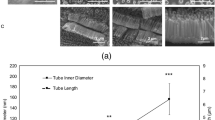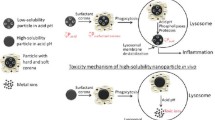Abstract
BACKGROUND:
In this study an approach was made to efficaciously synthesize gold enhanced titania nanorods by electrospinning. This study aims to address effects of gold enhanced titania nanorods on muscle precursor cells. Additionally, implant related microbial infections are prime cause of various disastrous diseases. So, there is predictable demand for synthesis of novel materials with multifunctional adaptability.
METHODS:
Herein, gold nanoparticles were attached on titania nanorods and described using many sophisticated procedures such as XRD, SEM, EDX and TEM. Antimicrobial studies were probed against Gram-negative Escherichia coli. C2C12 cell lines were exposed to various doses of as-prepared gold enhanced titania nanorods in order to test in vitro cytotoxicity and proliferation. Cell sustainability was assessed through Cell Counting Kit–8 assay at regular intervals. A phase-contrast microscope was used to examine morphology of exposed C2C12 cells and confocal laser scanning microscope was used to quantify cell viability.
RESULTS:
The findings indicate that titania nanorods enhanced with gold exhibit superior antimicrobial efficacy compared to pure titania. Furthermore, newly synthesized gold-enhanced titania nanorods illustrate that cell viability follows a time and concentration dependent pattern.
CONCLUSION:
Consequently, our study provides optimistic findings indicating that titania nanorods adorned with gold hold significant potential as foundational resource for develo** forthcoming antimicrobial materials, suitable for applications both in medical and biomedical fields. This work also demonstrates that in addition to being extremely biocompatible, titania nanorods with gold embellishments may be used in a range of tissue engineering applications in very near future.
Graphical Abstract







Similar content being viewed by others
Data availability statement
The datasets generated during and/or analysed during the current study are available from the corresponding author on reasonable request.
References
Csapo R, Gumpenberger M, Wessner B. Skeletal muscle extracellular matrix–what do we know about its composition, regulation, and physiological roles? Narrative Rev Front Physiol. 2020;11:253.
Pedersen BK, Febbraio MA. Muscles, exercise and obesity: skeletal muscle as a secretory organ. Nat Rev Endocrinol. 2012;8:457–65.
Abdel-Raouf N, Al-Enazi NM, Ibraheem IB. Green biosynthesis of gold nanoparticles using Galaxaura elongata and characterization of their antibacterial activity. Arab J Chem. 2017;10:S3029–39.
Aljabali AA, Akkam Y, Al Zoubi MS, Al-Batayneh KM, Al-Trad B, Abo Alrob O, et al. Synthesis of gold nanoparticles using leaf extract of Ziziphus zizyphus and their antimicrobial activity. Nanomaterials. 2018;8:174.
Yeh YC, Creran B, Rotello VM. Gold nanoparticles: preparation, properties, and applications in bionanotechnology. Nanoscale. 2012;4:1871–80.
da Rocha FR, Haupenthal DPdS, Zaccaron RP, Corrêa MEAB, Tramontin NdS, Fonseca JP, et al. Therapeutic effects of iontophoresis with gold nanoparticles in the repair of traumatic muscle injury. J Drug Target. 2020;28:307–19.
Opris R, Tatomir C, Olteanu D, Moldovan R, Moldovan B, David L, et al. The effect of Sambucus nigra L. extract and phytosinthesized gold nanoparticles on diabetic rats. Colloids Surf B: Biointerfaces. 2017;150:192–200.
Arvizo RR, Rana S, Miranda OR, Bhattacharya R, Rotello VM, Mukherjee P. Mechanism of anti-angiogenic property of gold nanoparticles: role of nanoparticle size and surface charge. Nanomed Nanotechnol Biol Med. 2011;7:580–7.
Saha S, **ong X, Chakraborty PK, Shameer K, Arvizo RR, Kudgus RA, et al. Gold nanoparticle reprograms pancreatic tumor microenvironment and inhibits tumor growth. ACS Nano. 2016;10:10636–51.
Shaheen TI, El-Naggar ME, Hussein JS, El-Bana M, Emara E, El-Khayat Z, et al. Antidiabetic assessment; in vivo study of gold and core-shell silver-gold nanoparticles on streptozotocin-induced diabetic rats. Biomed Pharm. 2016;83:865–75.
Ge J, Liu K, Niu W, Chen M, Wang M, Xue Y, et al. Gold and gold-silver alloy nanoparticles enhance the myogenic differentiation of myoblasts through p38 MAPK signaling pathway and promote in vivo skeletal muscle regeneration. Biomaterials. 2018;175:19–29.
Al-Shwaheen A, Aljabali AA, Alomari G, Al Zoubi M, Alshaer W, Al-Trad B, et al. Molecular and cellular effects of gold nanoparticles treatment in experimental diabetic myopathy. Heliyon. 2022;8:e10358.
Ehlert M, Roszek K, Jędrzejewski T, Bartmański M, Radtke A. Titania nanofiber scaffolds with enhanced biointegration activity—preliminary in vitro studies. Int J Mol Sci. 2019;20:5642.
Nel AE, Mädler L, Velegol D, **a T, Hoek EM, Somasundaran P, et al. Understanding biophysicochemical interactions at the nano–bio interface. Nat Mater. 2009;8:543–57.
Shin YJ, Lee HI, Kim MK, Wee WR, Lee JH, Koh JH, et al. Biocompatibility of nanocomposites used for artificial conjunctiva: in vivo experiments. Curr Eye Res. 2007;32:1–10.
Martin J, Dean D, Cochran D, Simpson J, Boyan B, Schwartz Z. Proliferation, differentiation, and protein synthesis of human osteoblast-like cells (MG63) cultured on previously used titanium surfaces. Clin Oral Implant Res. 1996;7:27–37.
Yoo KC, Yoon CH, Kwon D, Hyun KH, Woo SJ, Kim RK, et al. Titanium dioxide induces apoptotic cell death through reactive oxygen species-mediated Fas upregulation and Bax activation. Int J Nanomed. 2012;15:1203–14.
Amna T, Hassan MS, Shin W-S, Van Ba H, Lee H-K, Khil M-S, et al. TiO2 nanorods via one-step electrospinning technique: a novel nanomatrix for mouse myoblasts adhesion and propagation. Colloids Surf B. 2013;101:424–9.
Amna T, Shamshi Hassan M, Khil MS, Lee HK, Hwang I. Electrospun nanofibers of ZnO-TiO2 hybrid: characterization and potential as an extracellular scaffold for supporting myoblasts. Surf Interface Anal. 2014;46:72–6.
Amna T, Hassan MS, Khil M-S, Hwang I. Interaction of magnetic cobalt based titanium dioxide nanofibers with muscle cells: in vitro cytotoxicity evaluation. J Solgel Sci Technol. 2014;69:338–44.
Dykman L, Khlebtsov N. Gold nanoparticles in biomedical applications: recent advances and perspectives. Chem Soc Rev. 2012;41:2256–82.
Kumar A, Zhang X, Liang XJ. Gold nanoparticles: emerging paradigm for targeted drug delivery system. Biotechnol Adv. 2013;31:593–606.
Zhang D, Liu D, Zhang J, Fong C, Yang M. Gold nanoparticles stimulate differentiation and mineralization of primary osteoblasts through the ERK/MAPK signaling pathway. Mater Sci Eng, C. 2014;42:70–7.
Ko WK, Heo DN, Moon HJ, Lee SJ, Bae MS, Lee JB, et al. The effect of gold nanoparticle size on osteogenic differentiation of adipose-derived stem cells. J Colloid Interface Sci. 2015;438:68–76.
Heo DN, Ko WK, Bae MS, Lee JB, Lee DW, Byun W, et al. Enhanced bone regeneration with a gold nanoparticle–hydrogel complex. J Mater Chem B. 2014;2:1584–93.
Zuk PA, Zhu M, Ashjian P, De Ugarte DA, Huang JI, Mizuno H, et al. Human adipose tissue is a source of multipotent stem cells. Mol Biol Cell. 2002;13:4279–95.
Lee SJ, Heo DN, Lee HR, Lee D, Yu SJ, Park SA, et al. Biofunctionalized titanium with anti-fouling resistance by grafting thermo-responsive polymer brushes for the prevention of peri-implantitis. J Mater Chem B. 2015;3:5161–5.
Heo DN, Ko WK, Lee HR, Lee SJ, Lee D, Um SH, et al. Titanium dental implants surface-immobilized with gold nanoparticles as osteoinductive agents for rapid osseointegration. J Colloid Interface Sci. 2016;469:129–37.
Younis AB, Haddad Y, Kosaristanova L, Smerkova K. Titanium dioxide nanoparticles: Recent progress in antimicrobial applications. Wiley Interdiscip Rev: Nanomed Nanobiotechnol. 2022;15:e1860.
Amna T, Hassan MS. Nanofibers and nanotextured materials: design insights. Bact Mech Environ Adv. 2023;13:2891.
Amna T, Gharsan FN, Shang K, Hassan MS, Khil M-S, Hwang I. Electrospun twin fibers encumbered with intrinsic antioxidant activity as prospective bandage. Macromol Res. 2019;27:663–9.
Algethami JS, Amna T, Alqarni SL, Alshahrani AA, Alhamami MA, Seliem AF, et al. Production of ceramics/metal oxide nanofibers via electrospinning: new insights into the photocatalytic and bactericidal mechanisms. Materials. 2023;16:5148.
Keirouz A, Chung M, Kwon J, Fortunato G, Radacsi N. 2D and 3D electrospinning technologies for the fabrication of nanofibrous scaffolds for skin tissue engineering: a review. Wiley Interdiscip Rev: Nanomed Nanobiotechnol. 2020;12:e1626.
Rahmati M, Mills DK, Urbanska AM, Saeb MR, Venugopal JR, Ramakrishna S, et al. Electrospinning for tissue engineering applications. Prog Mater Sci. 2021;117:100721.
Zulkifli MZA, Nordin D, Shaari N, Kamarudin SK. Overview of electrospinning for tissue engineering applications. Polymers (Basel). 2023;15:2418.
Amna T, Alghamdi AA, Shang K, Hassan MS. Nigella sativa-coated hydroxyapatite scaffolds: synergetic cues to stimulate myoblasts differentiation and offset infections. Tissue Eng Regen Med. 2021;18:787–95.
Amna T, Van Ba H, Vaseem M, Hassan MS, Khil MS, Hahn Y, et al. Apoptosis induced by copper oxide quantum dots in cultured C2C12 cells via caspase 3 and caspase 7: a study on cytotoxicity assessment. Appl Microbiol Biotechnol. 2013;97:5545–53.
Amna T, Hassan MS, Sheikh FA, Seo HC, Kim HC, Alotaibi N, et al. Natural mulberry biomass fibers doped with silver as an antimicrobial textile: a new generation fabric. Text Res J. 2021;91:2581–7.
Hassan MS, Amna T, Mishra A, Yun SI, Kim HC, Kim HY, et al. Fabrication, characterization and antibacterial effect of novel electrospun TiO2 nanorods on a panel of pathogenic bacteria. J Biomed Nanotechnol. 2012;8:394–404.
Ortiz-Benítez EA, Velázquez-Guadarrama N, Durán Figueroa NV, Quezada H, Olivares-Trejo JdJ. Antibacterial mechanism of gold nanoparticles on Streptococcus pneumoniae. Metallomics. 2019;11:1265–76.
Xu Y, Wen W, Wu JM. Titania nanowires functionalized polyester fabrics with enhanced photocatalytic and antibacterial performances. J Hazard Mater. 2018;343:285–97.
Jang YS, Amna T, Hassan MS, Kim HC, Kim JH, Baik SH, et al. Nanotitania/mulberry fibers as novel textile with anti-yellowing and intrinsic antimicrobial properties. Ceram Int. 2015;41:6274–80.
Amna T. Bactericide gold decorated mulberry fibers for therapeutic and non-therapeutic tenacities. J Umm Al-Qura Univ Appl Sci. 2023;9:157–63.
Amna T, Hassan MS, Barakat NA, Pandeya DR, Hong ST, Khil MS, et al. Antibacterial activity and interaction mechanism of electrospun zinc-doped titania nanofibers. Appl Microbiol Biotechnol. 2012;93:743–51.
Vimbela GV, Ngo SM, Fraze C, Yang L, Stout DA. Antibacterial properties and toxicity from metallic nanomaterials. Int J Nanomedicine. 2017;12:3941–65.
Cui Y, Zhao Y, Tian Y, Zhang W, Lü X, Jiang X. The molecular mechanism of action of bactericidal gold nanoparticles on Escherichia coli. Biomaterials. 2012;33:2327–33.
Acknowledgements
The authors are thankful to the Deanship of Scientific Research at Najran University for funding this work, under the Research Groups Funding program grant code [NU/RG/SERC/12/45].
Author information
Authors and Affiliations
Contributions
TA and MSH: Conceptualization, methodology, formal analysis, investigation, resources, data curation, writing, original draft preparation, writing review and editing, JSA and AA: review and editing, AA: methodology, RA: formal analysis, FAS: writing review and editing, M-SKhil: resources, formal analysis and data curation.
Corresponding authors
Ethics declarations
Conflict of interest
There is no conflict of interest.
Ethical statement
Not applicable as there is no use of animal models for the experiments. All authors approve the submission.
Additional information
Publisher's Note
Springer Nature remains neutral with regard to jurisdictional claims in published maps and institutional affiliations.
Rights and permissions
Springer Nature or its licensor (e.g. a society or other partner) holds exclusive rights to this article under a publishing agreement with the author(s) or other rightsholder(s); author self-archiving of the accepted manuscript version of this article is solely governed by the terms of such publishing agreement and applicable law.
About this article
Cite this article
Amna, T., Shamshi Hassan, M., Algethami, J.S. et al. Characterization of Gold-Enhanced Titania: Boosting Cell Proliferation and Combating Bacterial Infestation. Tissue Eng Regen Med 21, 711–721 (2024). https://doi.org/10.1007/s13770-024-00630-8
Received:
Revised:
Accepted:
Published:
Issue Date:
DOI: https://doi.org/10.1007/s13770-024-00630-8




